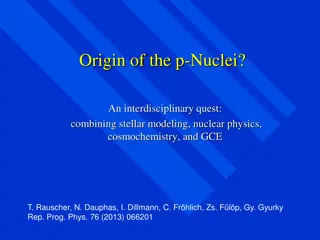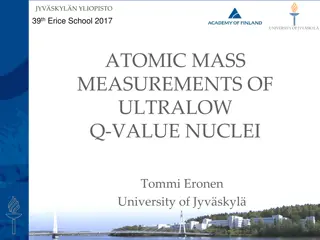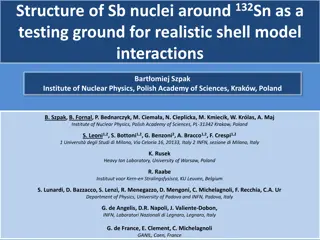Research Program on Spin Polarized Nuclei in Fusion Plasmas
Examination of spin polarized fuel in fusion plasmas to enhance energy production efficiency. Planned experiments aim to measure the lifetime of polarized nuclei for optimized fusion reactions. Key aspects include depolarization mechanisms, neutral beam heating, and fueling techniques with pellets.
5 views • 36 slides
Radioactive Decay and Nuclear Radiation
Radioactive decay is the process in which unstable atomic nuclei emit charged particles and energy, transforming into different elements. This process involves the emission of alpha particles, beta particles, and gamma rays. Alpha particles consist of two protons and two neutrons, beta particles are
5 views • 31 slides
Possible Analog States of the Hoyle State in Heavier Nuclei
Research conducted at the National Research Centre, Kurchatov Institute, explores possible analogs of the Hoyle state in heavier 4N nuclei, focusing on the 7.65 MeV 0+2 state in 12C (Hoyle state). The study reveals insights into the structure and characteristics of the Hoyle state, crucial for under
2 views • 12 slides
Pascal's Rule in NMR Spectroscopy ( n+1 )
Pascal's Rule in NMR spectroscopy, also known as the (N+1) rule, is an empirical rule used to predict the multiplicity and splitting pattern of peaks in 1H and 13C NMR spectra. It states that if a nucleus is coupled to N number of equivalent nuclei, the multiplicity of the peak is N+1. The rule help
12 views • 30 slides
Temperature Independent Paramagnetism (TIP) and Anomalous Magnetic Moments in Metal Ions
Temperature Independent Paramagnetism (TIP) explains the second-order Zeeman effect's magnetic susceptibility unaffected by temperature changes. Anomalous magnetic moments are observed in metal ions, deviating from predicted values based on electron angular momenta. The interaction of spin states in
6 views • 15 slides
Radioactivity in Modern Physics
Radioactivity is the spontaneous emission of radiation by unstable atomic nuclei, seeking a more stable configuration. It can be measured using the becquerel as the SI unit, with factors determining nuclear stability being neutron/proton ratio and number of nucleons. The Law of Radioactive Decay exp
3 views • 18 slides
Neuroanatomy Brainstem Slides Self-Assessment Study Guide
Explore detailed slides of brainstem structures for self-assessment and study purposes. Identify key areas such as spinal cord, pyramidal decussation, sensory decussation, and vagal nuclei with visual aids. Enhance your knowledge of neuroanatomy with labeled diagrams and information on various tract
5 views • 13 slides
States Analogous to 12C Hoyle State in Heavy Nuclei Using Inverse Kinematics
The study discusses the search for states similar to the 12C Hoyle state in heavier nuclei through the thick target inverse kinematics technique. It explores alpha clustering in nuclei, the thick target inverse kinematics method, events with alpha multiplicities, and more experimental details relate
1 views • 19 slides
The Origins of p-Nuclei: An Interdisciplinary Exploration
The study delves into the origin of p-nuclei, which are not produced by s- and r-processes. It discusses their scarcity, involvement in stellar processes, and potential production mechanisms like the p-process. Various scenarios and challenges in explaining the abundance of p-nuclei are also elabora
5 views • 35 slides
Mechanism of Low-Energy Nuclear Reactions in Low-Temperature Plasma
This work discusses nuclear-chemical processes underlying low-energy nuclear reactions in low-temperature plasma environments, focusing on the initiation of artificial radioactivity in metal cathodes under protium- and deuterium-containing nonequilibrium plasma conditions. The role of electrons with
8 views • 6 slides
Nucleonic Halos in Isobar-Analog States at Kurchatov Institute
The research at Kurchatov Institute focuses on investigating nucleonic halos in isobar-analog states (IASs) of nuclei, aiming to understand the structure and properties of exotic nuclei with neutron halos. Neutron halos, characterized by enlarged radii of valence neutrons, have been observed in both
0 views • 15 slides
Code Assignment for Deduction of Radius Parameter (r0) in Odd-A and Odd-Odd Nuclei
This code assignment focuses on deducing the radius parameter (r0) for Odd-A and Odd-Odd nuclei by utilizing even-even radii data from 1998Ak04 input. Developed by Sukhjeet Singh and Balraj Singh, the code utilizes a specific deduction procedure to calculate radius parameters for nuclei falling with
2 views • 12 slides
Significance of Pear-Shaped Nuclei in Atomic Physics
Causes of deformation in atomic nuclei, leading to pear-shaped structures, are explored with examples such as 224Ra and 220Ra. Measurement of Barium isotopes using advanced techniques sheds light on the spatial asymmetry of nuclei. The significance of pear-shaped nuclei in explaining CP-symmetry bre
4 views • 7 slides
Active Galactic Nuclei and Black Hole Mass Measurements
Exploring active galactic nuclei (AGN) through reverberation mapping techniques to measure black hole masses, observing AGN schematics, ultraviolet-optical AGN spectra, and methods for measuring masses in space. Delve into the current understanding of AGN fields, the future prospects, and ongoing re
0 views • 30 slides
Anomalous Heat Transport in Mathematical Physics
Anomalous heat transport deviates from standard Fourier law, exhibiting divergent heat conductance and non-trivial temperature profiles. Observations include long-range time correlations and divergent temperature gradients at boundaries. Models like coupled oscillators and hard disks with alternatin
4 views • 43 slides
Atomic Mass Measurements of Ultralow Q-Value Nuclei at University of Jyvaskyla
Explore the cutting-edge research on atomic mass measurements of ultralow Q-value nuclei conducted at the University of Jyvaskyla. This research delves into various techniques such as Penning trap atomic mass spectroscopy and PI-ICR to study Q-values for reactions and neutrino studies. The investiga
0 views • 29 slides
Alpha Cluster Structure in Nuclei Using Thick Target Inverse Kinematics Technique
Exploring the alpha cluster structure of nuclei through the thick target inverse kinematics technique for multiple alpha decays. This study investigates alpha clustering in nuclei, potential alpha condensates, and the application of the inverse kinematics technique in detecting multiple alpha emissi
0 views • 14 slides
Anomalous EEE Events During Multimessenger Observations
On Sept. 22, 2017, a high-energy neutrino event was observed by the IceCube Neutrino Observatory, potentially associated with a blazar. A search for anomalous EEE events during this period identified active telescopes and investigated coincident events. The significance of N-fold coincidences was di
1 views • 20 slides
Resistant Learning on the Envelope Bulk for Anomalous Patterns Detection
Outlier detection often relies on incremental learning to adjust boundaries for identifying majority patterns and recognizing anomalies. This study introduces a resistant learning algorithm with an envelope module that evolves a nonlinear fitting function wrapped in a constant-width envelope. The al
3 views • 21 slides
Development of Female Gamete and Embryo Sac in Plant Reproduction
In plant reproduction, the formation of female gametes involves meiosis in cells of the carpel sac, leading to the development of the embryo sac or megaspore. Meiosis results in four haploid cells, of which three degenerate, and one survives. This surviving cell undergoes multiple rounds of mitosis,
0 views • 7 slides
Investigation of Short-Range Correlations in Heavy Ion Collisions
Short-range correlations in nuclei play a crucial role in understanding the properties of nuclear wave functions and the transition from baryonic to quark-gluon degrees of freedom. Early theoretical work emphasized the importance of short-range correlations, particularly in modeling the nucleon spec
3 views • 17 slides
Auditory Pathway in the Brain: Nuclei, Pathways, and Connections
Explore the anatomy of the 8th cranial nerves, specifically the auditory pathway in the brain. Learn about the nuclei related to vestibular and cochlear nerves, their types and locations, along with descriptions of the vestibular and auditory pathways. Discover the primary auditory cortex, medial ge
2 views • 23 slides
Role of Anomalous Triangle Singularity in Threshold Phenomena Understanding
Anomalous Triangle Singularity (ATS) is explored in the context of threshold phenomena understanding, focusing on its occurrence when all three internal particles are simultaneously on shell. The study delves into kinematic effects, genuine states recognition, and specific cases such as heavy pentaq
4 views • 36 slides
Compilation and Evaluation of Experimental Data for Nuclei in Z=2-28 Region
Completed compilation and evaluation of experimental Pn and half-lives for nuclei in the Z=2-28 region, led by Balraj Singh at McMaster University. The work involved preparing lists of neutron-rich nuclides, identifying potential emitters, analyzing available experimental data for 1n, 2n, 3n, and 4n
4 views • 20 slides
Systematic Reduction of Proton-Removal Cross Section in Neutron-Rich Medium-Mass Nuclei
Single-nucleon knock-out reactions in neutron-rich medium-mass nuclei were studied to investigate the reduction of proton-removal cross section. Short-range correlated nucleon pairs, especially protons, were found to impact the probability of single-proton removal processes. Experimental measurement
0 views • 8 slides
Updates on UCR Group Medium Energy and STAR Forward Upgrade
UCR Group has updates on faculty, postdocs, grad students, and ongoing projects in Medium Energy and Heavy-Ion domains. The STAR Forward Upgrade focuses on Calorimeter System R&D for EIC Detector. TMDs research at STAR is advancing with data on higher x values and Q2 at 100 GeV2. Initial State of Nu
2 views • 4 slides
Anomalous IP Processing Electronics Diagnostic Tests
Repeating some anomalous IP processing electronics diagnostic tests on the first stage and the limiter. Tests include checking for unwanted harmonics in the frequency multiplier output and observing changes in the output power with varying input power. Issues with the output of the limiter diode and
4 views • 15 slides
Measurement of F2 EMC Effect in Deep Inelastic Electron Scattering Off Nuclei
MARATHON experiment at JLab aims to measure cross-section ratio of deep inelastic electron scattering from 3H and 3He mirror nuclei to determine ratios of structure functions and proton quark distribution functions using novel methods. The experiment will also explore the EMC effect for A=3 nuclei,
2 views • 35 slides
Realistic Shell Model Interactions in Nuclei
Bartłomiej Szpak and team from the Polish Academy of Sciences explore the structure of Sb nuclei around 132Sn to test realistic shell model interactions. They propose cluster transfer reactions and conduct calculations around 132Sn using a parameter-free approach. Limited experimental data is avail
5 views • 11 slides
QCD Effects in the Muon Anomalous Magnetic Moment
Muon's magnetic moment and anomalous g-2, quantum effects, experimental studies at BNL, Fermilab, JPARC. Hadronic Vacuum Polarization, quark properties, Dyson-Schwinger Equation, Bethe-Salpeter Equations discussed with visual aids.
2 views • 11 slides
Monopole Transitions in Light Unstable Nuclei - Research Insights
Explore the analysis and significance of isoscalar monopole transitions in light unstable nuclei, with a focus on the study of 10Be. Discover the results, Thomas-Ehrman shift, and cluster structures in 4N nuclei, along with the extension of the MO model for highly excited states. Delve into previous
0 views • 12 slides
Efficient Anomalous Database Transaction Detection and Proposed Solutions
Explore the challenges in detecting anomalous transactions in databases along with proposed solutions to reduce false positives, detection time, and handle new attributes effectively. The importance of addressing false alerts is highlighted, and a detailed methodology involving training and detectio
3 views • 7 slides
Tensor-Optimized Antisymmetrized Molecular Dynamics
Explore the innovative Tensor-Optimized Antisymmetrized Molecular Dynamics (TOAMD) method for light nuclei with direct treatment of VNN interactions. Gain insights into the variational approach for nuclei, deuteron properties, and the formulation of TOAMD. Discover how TOAMD describes finite nuclei
2 views • 31 slides
X-ray Scattering and MAD Techniques in Crystallography
Explore the world of X-ray scattering, Bragg's Law, anomalous scattering, and Multiple Anomalous Diffraction (MAD) techniques in crystallography. Discover how photon energy and cross-section play a crucial role in understanding atomic structures using X-ray beams.
4 views • 48 slides
Temperature Independent Paramagnetism (TIP) and Anomalous Magnetic Moments
Explore the concept of Temperature Independent Paramagnetism (TIP) and Anomalous Magnetic Moments in metal ions with unique symmetries. Learn about the magnetic susceptibilities, spin states equilibrium, and the behavior of nickel complexes in different configurations.
2 views • 15 slides
Importance of Gamow-Teller Transitions in Nuclear Astrophysics
Gamow-Teller transitions play a crucial role in understanding the nuclear structure and excited states within nuclei. These transitions, along with Fermi transitions, provide valuable insights into beta decay processes, weak interactions, and isospin interactions in nuclei. By studying the selection
3 views • 19 slides
Exploring Anomalous Quartic Gauge Couplings with Machine Learning
Delve into the study of anomalous quartic gauge couplings (aQGCs) using machine learning algorithms at Liaoning Normal University. Discover the significance of aQGCs in high-energy physics research, including their impact on VBS processes and extraction of energy in collider experiments. Explore the
3 views • 31 slides
Quantum Hydrodynamic Approach for Heavy Ion Collisions
Explore the emission of fragments in collisions of intermediate-energy heavy ions using a non-equilibrium quantum hydrodynamic approach. This study delves into fragment factorization, distribution profiles, and agreement with experimental data on collisions of gold and carbon nuclei. The model offer
2 views • 18 slides
Anomalous U(1) Couplings and Columbia Plot by Rui Wen
Explore anomalous U(1) couplings and the Columbia plot presented by Rui Wen on October 12, 2024. The research delves into potential chiral phase transitions and sharp crossovers in low-temperature phases. Discover more about these intriguing findings in the scientific community.
0 views • 11 slides
Anomalous U(1) Couplings and Columbia Plot Overview
Delve into the intriguing world of anomalous U(1) couplings and the Columbia plot discussed by Rui Wen on October 12, 2024. Explore the potential absence of a true chiral phase transition and the existence of a sharp crossover in low-temperature phases. Dive deeper into the presented content through
1 views • 11 slides







































